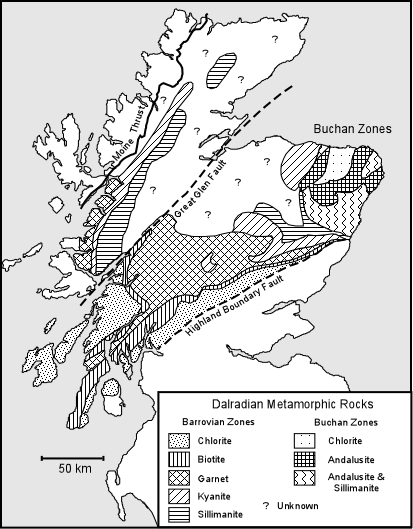
| EENS 2120 |
Petrology |
| Prof. Stephen A. Nelson |
Tulane University |
|
Regional Metamorphism |
|
| Regional metamorphism is metamorphism that occurs over broad areas of the crust. Most
regionally metamorphosed rocks occur in areas that have undergone deformation during an
orogenic event resulting in mountain belts that have since been eroded to expose the
metamorphic rocks. Barrovian Facies Series The Dalradian and Moinian Series of Scotland |
| The rocks were originally shales, limestones, diabase sills, and basalts that had been emplaced in the Precambrian to early Cambrian. In this area, Barrow (1893) mapped metamorphic zones in pelitic rocks based on mineral assemblages he observed in a small part the area. This mapping was later extended across the Scottish Highlands to cover most of the Dalradian and Moinian Series as shown in the map. The series of metamorphic zones mapped by Barrow has since become known as the Barrovian Facies Series (At the time Barrow did his mapping, the facies concept had not yet been developed). In pelitic rocks, Barrow recognized 6 zones of distinctive mineral assemblages, which he recognized as representing increasing grade of metamorphism. |  |
| The boundaries for his zones were based on the first appearance of a particular mineral, called an index mineral, which is characteristic of the zone. These boundaries were later called isograds (equal grade) and likely represent surfaces in a three dimensional sense. He called the zone of lowest grade rocks the "zone of digested clastic mica," but Tilley, mapping the area in 1925, renamed this zone the chlorite zone. |
Zone |
Mineral Assemblage in Pelitic Rocks |
| Chlorite (slates & phyllites) | quartz, chlorite, muscovite, albite |
| Biotite (phyllites & schists) | biotite begins to replace chlorite, quartz, muscovite, albite |
| Garnet (phyllites and schists) | quartz, muscovite, biotite, almandine, albite |
| Staurolite (schists) | quartz, biotite, muscovite, almandine, staurolite, oligoclase |
| Kyanite (schists) | quartz, biotite, muscovite, oligoclase, almandine, kyanite |
| Sillimanite (schists & gneisses) | quartz, biotite, muscovite, oligoclase, almandine, sillimanite |
Mineral assemblages for pelitic rocks of the Barrovian Zones are listed in the table above. Note the following important points:
|
As mentioned above, Tilley mapped the area in 1925, and extended the zones across the
area between the Highland Boundary Fault and into the Moinian Series, and renamed the
chlorite zone. Later, Wiseman (1934), mapped the metabasic rocks and Kennedy (1949)
mapped the meta calcareous sediments. Mineral assemblages in these rocks and their
correlation with the metamorphic zones in the pelitic rocks are shown in the table below. |
Index Mineral |
Basic Rocks | Calcareous Rocks | Facies |
| Chlorite | Chlorite, albite, epidote, sphene,
▒ calcite ▒ actinolite |
Greenschist |
|
| qtz, muscovite, biotite, calcite | |||
| Biotite | garnet, zoisite, sodic plagioclase, biotite or hornblende | ||
| Garnet | Hornblende, plagioclase, ▒epidote, ▒almandine, ▒diopside |
Amphibolite |
|
| Staurolite | garnet, anorthite or bytownite, hornblende | ||
| Kyanite | |||
| Sillimanite | garnet, anorthite or bytownite, pyroxene |
| Note that the metabasic rocks only define two zones, one corresponding to the chlorite and biotite zones in the pelitic rocks, and the other corresponding to the staurolite, kyanite, and sillimanite zones. The calcareous rocks define four zones. The lowest grade rocks are only metamorphosed in the higher grade parts of the pelitic chlorite zone, another set of minerals occurs in the calcareous rocks throughout the biotite and garnet zones, another mineral assemblage is characteristic of the staurolite and kyanite zone, and a fourth mineral assemblage is found in calcareous rocks of the sillimanite zone. Note how the Anorthite content of plagioclase increases with increasing grade of metamorphism in the basic rocks and the calcareous rocks. The facies concept was developed by Eskola in 1939. Recall that the names of Eskola's facies are based on mineral assemblages found in metabasic basic rocks. Applying the facies concept to the Dalradian series of Scotland, one finds only two facies represented. The chlorite and biotite zones represent greenschist facies metamorphism, and the garnet, staurolite, kyanite, and sillimanite zones represent amphibolite facies metamorphism. The structural history of the Dalradian and Moinian Series is complex. Deformation can be divided into three main stages, based on structures found in the rocks and radiometric dating.
These events occurred during the Caledonian Orogeny, when the European continental block was colliding with the North American continental block, thus, in North America, this event is correlative with the Appalachian Orogenies. . |
| There is apparently no correlation with stratigraphic depth in the Dalradian metamorphic rocks, although there must be a correlation with tectonic depth. Pressure - Temperature estimates for the Sillimanite zone indicate a maximum temperature of about 700oC and maximum pressure of about 7 kb. This corresponds to a depth of about 25 km, and gives a geothermal gradient of about 28oC /km (compared to a normal stable continental geotherm of 25oC /km |
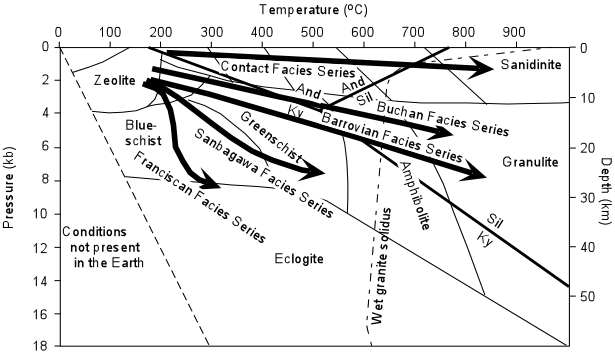 |
| Barrovian Facies Series of the Southern Appalachians The Barrovian Facies Series occurs in the southern Appalachians, extending from Central Virginia to Alabama. Interpretation of the relationship between deformation and metamorphism is complicated by two factors:
|
|
|
The Buchan Facies Series of regional metamorphism is characterized by the presence of andalusite, and sometimes cordierite, in intermediate grade mineral assemblages indicating that the conditions of metamorphism were at lower pressure and along a higher metamorphic field gradient than that recorded in Barrovian Facies Series metamorphic rocks . The type locality of Buchan Facies Series metamorphism is in northeastern Scotland (see map above) in the Dalradian Series. Here the pelitic rocks in the mapped zones contain the following mineral assemblages:
|
High Pressure Facies Series Franciscan Facies Series |
|
Typical mineral assemblages are as follows:
|
| Sanbagawa Facies Series |
| The Sanbagawa Belt is part of a complex that was accreted to
Japan during the Mesozoic. Like the Franciscan Complex, the Sanbagawa Belt contains
rocks of the blueschist facies. But, unlike the Franciscan Complex, the
Sanbagawa Belt rocks are dominated by pelitic rocks, although basic and calcareous rocks
occur, along with some metagraywackes. Also, unlike the Franciscan rocks, the
facies sequence is zeolite - prehnite-pumpellyite - blueschist - greenschist -
amphibolite, indicating somewhat higher temperatures than in the Franciscan Complex.
Representative mineral assemblages for various rock compositions in the Sanbagawa Facies Series are listed below: |
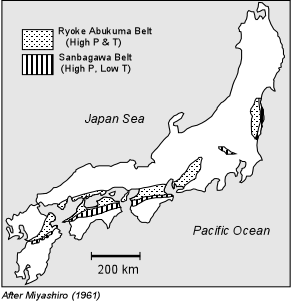 |
|
Paired Metamorphic Belts In 1961, Miyashiro noted that in the cicumpacific region, belts of high pressure, low temperature metamorphism on the oceanic side were associated with belts of high pressure, high temperature metamorphism on the continent side. He termed such an occurrence - Paired Metamorphic Belts. The two examples he cited are:
|
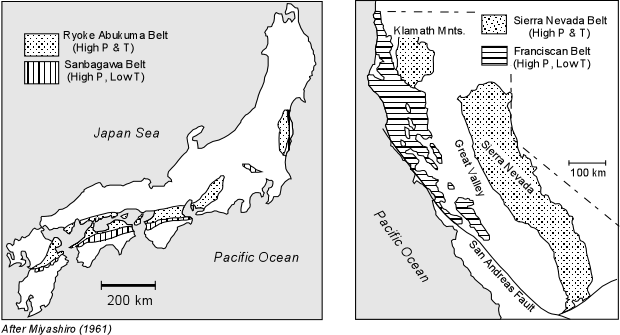 |
| Other occurrences of paired belts have since been recognized throughout the world (see
figure 19-12, page 387 in your text) and include areas in New Zealand, Indonesia,
Washington State, in the U.S., Chile, and Jamaica. Other such paired belts have been
recognized in the Alps of central Europe, the northern coast of South America. Most of these areas show evidence of having been associated with convergent plate
margins, where subduction has occurred. It appears that subduction is necessary to
produce the low geothermal gradient necessary to form the belt of high pressure and low
temperature. Such belts are probably not more commonly persevered in the geologic
record because during blueschist facies metamorphism hydrous minerals are still present.
Only if these rocks are uplifted and exposed at the surface relatively rapidly
after subduction ceases would they escape being overprinted by facies of normal geothermal
gradient, because there would still be fluids available to make the greenschist and
amphibolite facies mineral assemblages. The high pressure- high temperature belts are expected to form in areas beneath the
island arc or continental margin volcanic arc. During emplacement of the arc, these
areas are subject to higher than normal geothermal gradients that could produce Buchan
Facies Series metamorphic Rocks. Furthermore, emplacement of batholiths and
isostatic adjustment after magmatism has ceased cause these belts of high T, high P
metamorphism to be uplifted and exposed at the surface. In the case of the Japanese paired belts, the two belts are adjacent to one another
likely because subduction has moved farther off the coast. Compressional tectonics between
the Pacific and Eurasian Plate has accreted the island arc and trench complex to Japan at
the end of the Mesozoic. |
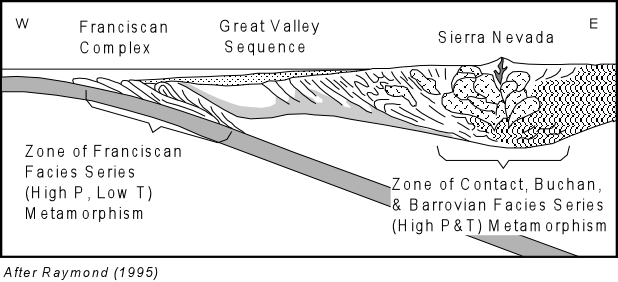 |
Examples of questions on this material that could be asked on an exam
|